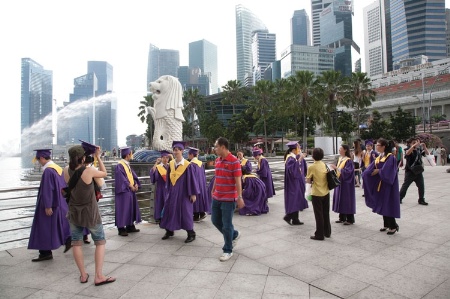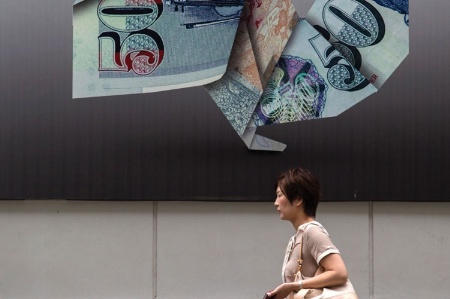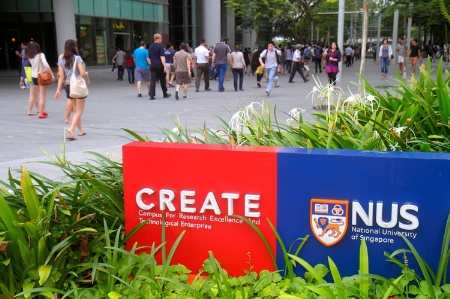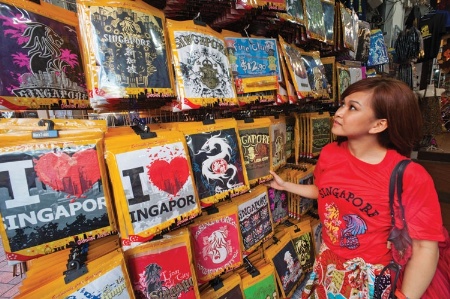Source: Getty
Singapore’s system is explicitly planned by the government to serve the needs of the economy in a way that would be unthinkable in the UK
In the space of just a few generations, Singapore has transformed itself from an impoverished colonial outpost into a country with a higher per capita gross domestic product than the US.
Something similar appears to be happening to its academy. Singapore’s two strongest research universities have leapt from the “Fourth Division to the Champions League” over the past decade, says Bertil Andersson, who is president of one of them, Nanyang Technological University.
In May, Singapore became the first Asian nation to break into the top 10 of the Universitas 21 rankings, which assess countries’ academies on the basis of their investment, gender balance, international connectivity and research output. And Nanyang has risen from joint 169th in the Times Higher Education World University Rankings two years ago to 76th in 2013-14. Its main domestic rival, the National University of Singapore, rose from 40th to 26th over the same period.
Meanwhile, other wealthy city states such as Abu Dhabi, Dubai and Qatar, which have invested huge sums in luring prestigious Western universities to their shores, have conspicuously failed to make the same impact on the global research stage.
Yet despite the outwardly gleaming success of Singapore’s universities, there are a number of serious concerns about its higher education system. These include limits on academic freedom, the challenges posed by the lack of land in the tiny island state, and a rising popular feeling that “Singapore is for Singaporeans”, a stance that is making some foreign universities feel unwelcome.
It is just a half-hour taxi ride from Singapore’s high-rise central district to Nanyang’s main campus in the far west of the city. It does not feel very different from a leafy, out-of-town campus in the UK – except for the tall, lush ferns, a Chinese garden dotted with pagodas and, of course, the tropical humidity. If it weren’t for the hills to Nanyang’s west, it would be possible to look across the Straits of Johor to Malaysia.
Singapore still boasts one of the world’s busiest ports, but it has almost no natural resources. For this reason, investment in higher education “is an imperative, not a choice”, says Lim Chuan Poh, chairman of the country’s Agency for Science, Technology and Research and former permanent secretary of the Ministry of Education.
“People are our only resource,” Lim explains – a fact that has concentrated minds in the Singaporean government on the importance of education.
Some might imagine it would be easy for such a wealthy state to spend its way to world-class universities. After all, this is a country in which around one household in every dozen boasts a US dollar millionaire (excluding property, businesses and luxury goods), according to a report published earlier this year by the Boston Consulting Group.
But Singapore spends only 2.8 per cent of its GDP on education, the Organisation for Economic Cooperation and Development found in 2010, compared with an average of 5.2 per cent across the body’s member countries. The system is therefore run on a “lean basis”, explains Lim. Competition for funding is encouraged between the two leading universities. He compares this to the UK – which he sees as having a “very sensible” system that distributes funding competitively.
Singapore has tried to create “sharp peaks of excellence” within the institutions, Lim adds, and since 2007 has established five research centres of excellence in the National University and Nanyang studying areas ranging from quantum technologies to earthquakes. In setting up these centres, he says, the question at the forefront of the funders’ minds was: “In five to seven years’ time, will this centre…be one of the top three, the top five in the world?”
Despite the “lean basis”, Singapore unarguably has thrown a huge amount of money at its universities’ research capabilities. Since 1991, it has rolled out five five-year plans to improve science, technology and innovation. The first was worth S$2 billion; the second, in 1996, provided S$4 billion; the third, started in 2001, was worth S$6 billion; the fourth, begun in 2006, was worth S$13.9 billion; while the current 2011-15 plan is worth S$16.1 billion (around £8 billion).
Much of this has gone into attracting international scholars and at Nanyang, academics from other countries far outnumber local staff: seven in 10 faculty members are non-Singaporean and a remarkable range of accents can be heard on campus. At the National University, about half of the academic staff are locals.
The government has also set aside S$4 billion for match funding (the government will match 150 per cent of the philanthropic donations to Singapore’s universities). The combined endowments of the National University and Nanyang doubled between 2005 and 2012 to S$3.4 billion.
But it is not only money that has bred success: the fact that English is Singapore’s official language is also a “tremendous advantage”, says Tan Chorh Chuan, president of the National University.
So is the quality of its school system. Singaporean schoolchildren are some of the best educated in the world, according to the 2009 and most recent survey of the OECD’s Programme for International Student Assessment, which measures 15-year-olds’ maths, science and reading skills: they come second in the world in maths, for example. By contrast, Qatar, ranked by some as the richest per capita country in the world, finished fifth from bottom – out of 65 – in all three subject areas. Dubai did better, but its school pupils still performed below the average.
“When I’m on the international circuit, people talk about Abu Dhabi and Singapore in the same breath,” complains Andersson. “I say it’s very different.”

Since the global financial crisis, jobs have become tougher to find, and the 2011 election delivered a message that ‘Singapore is for Singaporeans’
Singapore’s university system is explicitly planned by the government to serve the needs of the economy in a way that would be unthinkable in the UK.
One current concern for policymakers is that the city state’s graduates too often get stuck in the middle ranks of multinational corporations because they are seen – or are stereotyped, thinks Andersson – as hardworking yet lacking in creativity.
“You will not find many Singaporeans in top-level international positions,” says Arnoud De Meyer, president of the Singapore Management University, an institution founded in 2000 in part to address this problem. “Our ambition is to be successful in business, management and government.”
He predicts that within five to 10 years, the institution’s alumni “will start to reach chief executive positions”.
Government planning of the academy means that things get done – and fast, Andersson notes. Explaining his departure for Singapore from the European Science Foundation in 2007, he jokes that “maybe in Europe we talk too much and in Singapore they act…it’s do, do, do, do all the time”.
For example, it took only four years for Nanyang and Imperial College London to set up and build from scratch a new medical school. A similar undertaking on his native Swedish soil or in the UK would have dragged on for a decade or more, Andersson believes.
However, there is a troubling flip side to such state vigour and largesse, as THE found out when attempting to discuss local politics with one Nanyang employee. The person made it clear that the topic of conversation was off-limits, adding that it was prohibited by a clause in their contract. It is unclear how widespread this practice is.
Andersson is open about the fact that personal criticism of officials is off-limits.
“If I sit with the minister of education here, I can criticise him as much as I could criticise the Swedish minister,” he explains. “But if I go out to the press and say the minister is nuts – this you don’t do.”
There was controversy earlier this year when Cherian George, associate professor at Nanyang’s Wee Kim Wee School of Communication and Information and a strong critic of the government, was denied tenure, leading to claims that the decision was a result of his political views. Nanyang made no comment at the time, but Andersson later gave a speech stressing that tenure and promotion decisions were not influenced by such matters.
So far Singaporean universities have concentrated on subjects such as science, engineering and medicine, areas less likely to stray into politically sensitive zones. But the country is now trying to build up its reputation in the arts and humanities, partly to attract the creative industries. Academic freedom is therefore becoming an ever more pertinent issue.
Some in government remain cautious about this move, according to Andy Green, professor of comparative social science at the Institute of Education, University of London and an expert on education in the East Asian “tiger economies”. “But they are well aware that there are a number of areas in the service sector where it’s good to have a reputation for being exciting and creative. So they want to get rid of a reputation for being scientists and engineers.”
This summer marked the inaugural intake of the Yale-NUS College, a collaborative venture that gives students a classic US liberal arts education but with more Asian thinkers and writers introduced into the curriculum.
The tie-up is being described by Singapore’s government as proof of its respect for academic freedom. Yet last year, Yale’s arts and science faculty voted for a motion raising concerns about the “lack of respect for civil and political rights in the state of Singapore”, while the University of Warwick rejected proposals to establish a branch campus on the island in 2005 amid fears about a lack of academic freedom.
Areas of research that are off-limits include anything that might exacerbate racial or religious tensions, according to De Meyer. Interestingly, he believes that this restriction is justified in a “quite artificial” multiethnic and religiously plural country. Singapore sits between two much more populous Muslim-majority neighbours, so Islam is a “touchy” subject, he adds.
However, like most residents who spoke to THE, De Meyer believes that restrictions on what people can say have eased over the past decade. The country has been ruled by the People’s Action Party since independence in 1965 almost as a one-party state, but in the most recent elections in 2011 the PAP suffered a bloody nose. It was re-elected but with a record low of 60 per cent of the vote, and failed to win six of the 87 parliamentary seats.
This has coincided with signs of a relaxation of the country’s famously conservative culture, according to Suhaimy Hassan, principal policy officer at James Cook University, an Australian university with an outpost in Singapore. He mentions a gig in August by the US heavy metal band Metallica and argues that “10-15 years ago they wouldn’t have gotten through the airport with their long hair”. His comments suggest that Singapore might be shaking off its reputation for being, to put it bluntly, rather dull. Fairly or unfairly, this image used to make recruiting scholars to the city state a struggle, De Meyer admits.

The worst thing any country can create for itself is a lot of unemployed graduates protesting - because they make the most noise and create the most trouble
In 2000, “on Friday evening you would go to the airport and would find all the expats flying off to Bali because there was nothing to do in the city. That’s not the case any more,” he says.
Andersson becomes positively agitated by the question of whether Singapore is an interesting place to live. “It’s much more interesting than Sheffield…Birmingham…Stockholm…it’s probably one of the 10 most vibrant cities in the world,” he says.
Yet when THE spoke to Western expats, many became apologetic, even defensive, about how long they had lived in Singapore, often explaining that it was “convenient” and an easy place to raise children.
According to one academic who until recently worked in two major Singaporean universities for more than a decade (and asks not to be named), the country is a “very good place to be productive…but can be dull”.
“There is little variation in professional life…there are few social activities…and participation in outreach activities is not encouraged,” she says.
During a tour of the National University campus, it became apparent that there was no student bar: according to the guide, it had closed through lack of use.
Andersson argues that the island’s native-born population of 3 million people “is not enough to sustain this sector…you need to recruit [from overseas], it’s not a luxury”.
But it can also be difficult to encourage Singaporeans to choose the academic path. At Nanyang, for example, just 30 per cent of the postgraduates are locals.
Andersson blames this, in part, on the lure of money: a top business school student who goes into a bank after graduation will earn S$8,000 a month, but a PhD student can expect to take home only S$3,000. Postgraduates are also unable to start paying contributions to a government scheme set up to help Singaporeans buy a home.
“Money matters in this country,” says Andersson, adding that “it’s not a tradition…to go into an academic career”.
At just under 30 per cent of the young population, Singapore’s undergraduate enrolment rate is lower than most countries in Europe and North America, despite its per capita wealth.
The government’s aim is to boost this proportion to 40 per cent by 2020. To accommodate growth, the government has created institutions such as SMU and the Singapore University of Technology and Design (another sign of its desire to move into the creative sphere).
But at the same time, there are worries about having more graduates than there are jobs.
“There’s room for maybe one more institution,” Lim says, but stresses that it must be tailored to the needs of the labour market.
“The worst thing any country can create for itself is a lot of unemployed graduates protesting – because they make the most noise and create the most trouble,” he says with a smile.
It is unclear quite how much he is joking.
The island’s population is 5.4 million, but only 3.3 million are Singaporean citizens. The rest are foreign workers, or fall into the halfway house of “permanent residents”. Lim argues that this gives the country a “very thick buffer”: if the number of local graduates grows, they can slowly replace foreign workers.

At the National University, the graduate employment rate six months after leaving its traditionally strong schools of engineering, accounting and business is usually at least 90 per cent. Yet in the arts, social sciences and design – the very areas Singapore is trying to encourage – graduate prospects are not so assured: more than a quarter of those who take bachelor’s of arts degrees had not found permanent, full-time jobs when surveyed.
Many Singaporeans – some 8.8 per cent, according to the British Council – study abroad. De Meyer thinks that a large number of them would prefer to receive a (much cheaper) education at home if more places were available. He sees the push for greater enrolment as being about allowing more locals to study in Singapore, rather than boosting the proportion of the population holding degrees.
Either way, more students and more universities require more land, a supremely scarce commodity on such a tiny island. The country squashes 7,405 people into each square kilometre – the third-highest population density globally, according to the World Bank.
“Frankly speaking, if I have a problem, it is space,” says De Meyer. “About 90 per cent of the land earmarked for construction and development…is [built on] today. We will go up – you will see many more high-rises – and we will go down.”
Indeed, part of the SMU campus is underground and both Nanyang and the National University have completed preliminary studies to do likewise.
The scarcity of land, and the clamour for more Singaporeans to attend university, has created a problem for the private, foreign institutions invited to set up shop in the city around a decade ago.
The plan was for Singapore to generate income from foreign students – to become a regional “hub” rather like Hong Kong – but the dream has gone sour for some.
In July, the University of Chicago Booth School of Business announced it was pulling out of Singapore in favour of Hong Kong. The previous November, Tisch Asia, an arts school that is part of New York University, had made for the exit, reportedly because it was running huge deficits. And there was the spectacular failure of the University of New South Wales in 2007, which closed its Singapore branch after just one semester because it attracted far fewer students than hoped.
The mood at the Singapore branch of Australia’s James Cook – the biggest independent foreign recruiter of students on the island – is much more embattled than the upbeat atmosphere at the National University and Nanyang. Dale Anderson, head of the campus, insists that “we still survive here”, but complains of the rise in “anti-foreigner feeling”, particularly since the general election.
He says there is now a “big push to work just with Singaporeans” and to take more local students. At a recent meeting with residents, Anderson was asked to explain why James Cook had been given such a big plot of land when it mainly teaches non-Singaporeans. As a stand-alone foreign university it is not allowed to buy land, leaving it with a S$414,000 monthly rental bill.
De Meyer was one of the members of the economic review committee that in 2002 endorsed the plan for Singapore to become a hub for foreign students – the Global Schoolhouse initiative. But even he now admits that the demand from overseas students is “drying up”.
“Quite a few of the international students who came here, in particular from China, India and Indonesia, came with the expectation to find a job locally,” he explains.
In the past, “there were lots of jobs and the government was very liberal with its employment passes”, De Meyer says. But since the global financial crisis, jobs have become tougher to find, and the 2011 election delivered a “loud and clear” message to the government that “Singapore is for Singaporeans”.
So although the state’s two leading research universities are climbing the rankings, Singapore’s status as a regional hub for international students and institutions is on much shakier ground.
Meanwhile, its higher education system still arguably lags behind that of its main Asian rival (and fellow former British colony) Hong Kong. Despite having a marginally lower GDP than Singapore, Hong Kong appears to have greater strength in depth in higher education terms, with six institutions in the THE top 400, against Singapore’s two.
Lim is not complacent.
“There is still some way to go to reach world-class research excellence,” he says. “The whole notion of a research culture has not permeated through the many strata in our society. We are not there yet.”

Investing in the future: Singapore
- Number of publicly funded universities: 4
- Number of branch campuses, 2011: 17
- University enrolment, 2012: 57,989
- Polytechnic enrolment, 2012: 79,003
- Proportion of most recent school year cohort admitted to university (and Singapore Institute of Technology), 2012: .7 per cent
- Spending on education, 2010: 2.8 per cent of GDP
- Ministry of Education spending on tertiary education institutions, 2013: S$5.1 billion (£2.5 billion)
- Annual tuition fees for Singaporean citizen undergraduates at the National University of Singapore, excluding medicine and dentistry, 2013-14: S$7,650–S$10,800
Sources: Singaporean Ministry of Education, Singaporean Ministry of Finance, Observatory on Borderless Higher Education, Organisation for Economic Cooperation and Development, National University of Singapore
Register to continue
Why register?
- Registration is free and only takes a moment
- Once registered, you can read 3 articles a month
- Sign up for our newsletter
Subscribe
Or subscribe for unlimited access to:
- Unlimited access to news, views, insights & reviews
- Digital editions
- Digital access to THE’s university and college rankings analysis
Already registered or a current subscriber?
